Our Detour on the Intracoastal Waterway (ICW)
It’s well known among cruisers that the greatest risk to sailors is a schedule. However, we found ourselves up against the dreaded calendar when it came time to depart Annapolis and bring the boat to Charleston where we would be leaving it for a month while we took care of various matters on land. Actually, I shouldn’t say “on” land because part of what is happening in November is Rand’s trip underground to chart more of the Lechuguilla cave in New Mexico. We also have business to attend to, Thanksgiving with family and friends, and a week at least in NYC to visit my mom.
As it turned out, the weekend when we left the boat for Zack and Jess’ wedding was the last optimal time to depart Annapolis and sail around Hatteras for quite a while. So be it. The wedding weekend will stand as one of the best experiences in our lives.
When we arrived back from Philadelphia late on Sunday night, we did see that our window was closing. We briefly considered pushing off at Midnight, but realized that being rested was the most important thing we could do to ensure a safe passage.
We had a number of delivered items that had arrived while we’d been away, such as our new outboard motor and our life raft. Kelsey, who manages South Annapolis Yacht Centre, deserved our great thanks for holding these valuable items in her office and meeting us late Sunday evening to let us collect everything. Instead of sailing off at midnight, we made a party of installing the new motor on the dinghy and liferaft by the back port-side steps.
We knew the SW winds were building, which would make the trip down the Chesapeake more of a motor than a sail, and a bit uncomfortable as the waves would be hitting our bow. But we also knew if we didn’t leave now, we’d be leaving the boat in Annapolis, and that wasn’t ideal. So we checked and rechecked all our weather sources , especially Chris Parker’s, and decided to push off early Monday morning.
Another reason I wanted to depart Annapolis was that it had grown quite chilly to the point that we turned on the heat in the boat that last night. I couldn’t wait to get to clearer waters and bikini temperatures!
We left Spa Creek at the 8:30 am bridge opening and headed south, deciding that we would reassess whether we could sail out into the Atlantic around Hatteras or proceed by the Intracoastal Waterway. We’re lucky that the Antares is built with a mast height under the minimum height of bridges on the ICW, giving us the option of comfortably navigating on the inside.
The Chesapeake was a bit choppy and the first long day was all motoring into the southwest breeze, but we were able to follow Bay Shore Marine’s recommendation and rev up our engines higher than we had been used to doing…and, freshly serviced and tuned, they performed beautifully, giving us good speed and peace of mind.
I stayed up on my shift until about 2:30, then turned it over to Rand. We discussed what we’d learned about weather and seas during our long Monday progress down the Bay, and decided we’d be better off skipping the Atlantic around Hatteras and taking the ICW route. Click Here for what happened to some unfortunate sailors who didn’t make that decision and had to be rescued by the coast guard from 45 knot winds & 9 foot seas.
By 7AM the next morning, Rand was transiting Norfolk harbor, headed for the inland passage to Beaufort. We had decided to take the slightly longer, but more scenic, Dismal Swamp, route, which did not disappoint.
Traveling the Dismal Swamp route also gave us a chance to go through our first lock experience at Deep Creek Lock. The boats are taken up 8 feet there and then at the other end of the canal, at the South Mills Lock, you go back down. The locks operate on a fixed schedule. Timing openings of bridges and locks along the ICW is part of the cadence of navigating its waters.
Deep Creek lock was operated very efficiently by Robert, who also provides a wealth of information and tells you about the many countries whose boats have been through his lock lately. He has been on the job for the last several decades – and he is the “newest employee” of the Dismal Swamp lock system. The lack of turnover shows they must love their jobs!
The Dismal Swamp canal has a rich history, having been owned by President George Washington years before he became President, and being used as passage for slaves as part of the Underground Railway during the civil war era. Patrick Henry later became president of the Dismal Swamp corporation. The land was intended to be used for timber farming, but it didn’t prove particularly economical. The entire 22 miles of canal were dug entirely by hand (mostly by slaves).
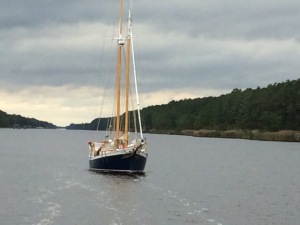
We pulled this boat off the mud after it moved over a few feet to let us do a two-whistle (port-side) pass, and got stuck in the mud.
All parts of the ICW have the risk of logs and tree stumps. We saw several. Another risk is running aground in the mud.
Some other facts of life if you navigate the ICW: you have to motor and can’t sail on the canals and narrow channels and rivers; you can only travel during the daylight hours; there is always a risk of running aground on mud (we pulled one sloop off mud they had become stuck on) hint: carry BoatUS Insurance; there are logs and tree stumps that could be right in the middle of the channel, so constant vigilance is required; and the water is dark brown from the tannins that leach out of the decaying leaves from the adjacent foliage, so your boat gets a “Carolina smile” that we cleaned off as soon as we were out of the ICW.
The rest of our ICW passage to Beaufort was uneventful. We spent Tuesday night in Elizabeth City at the city dock, arriving at dusk and leaving at dawn, and we stayed Wednesday night at Upper Dowry Creek at a very cost-efficient marina where we caught up on some work using their Internet.
The offshore passage after Beaufort was more spirited the first night, with steady sailing between 7 and 9 knots. Then the wind began to lighten, so we used the time to work on the boat, doing things like hanging the life raft, commissioning the watermaker (which had been pickled all summer while we had access to good USA water), putting away our new Parasailor in the sail locker, and regular boat maintenance.
When day was done, the sea was glassy like a lake. We stopped and drifted and enjoyed cocktails and watched the sunset.Then we continued on to Charleston.

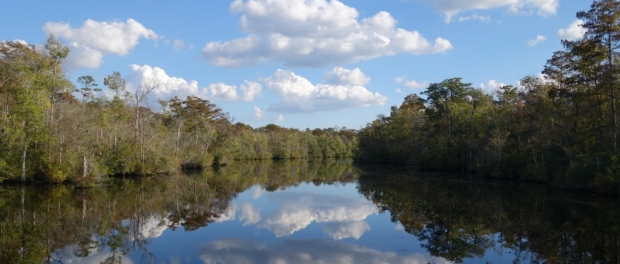
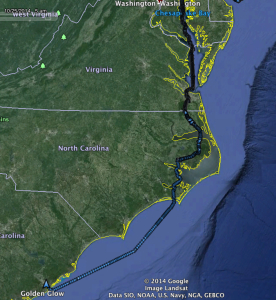
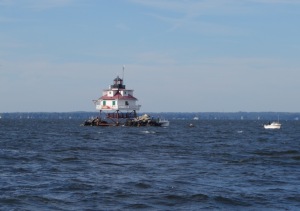

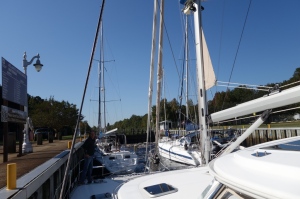
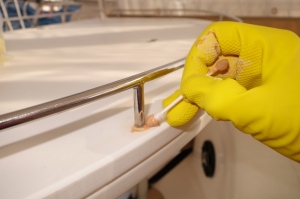
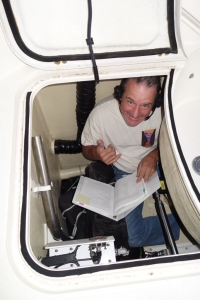
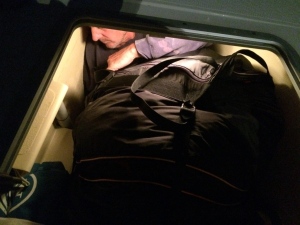
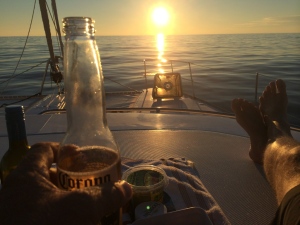
Leave a comment